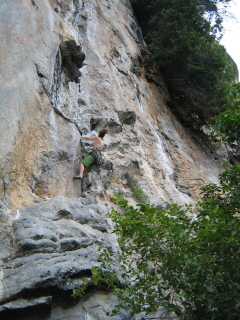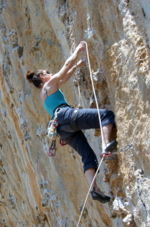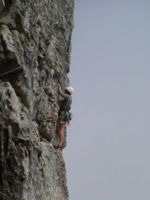Rock climbing
Contents
The basics of Rock Climbing
Indoors and outdoors climbing
Rock climbing is a wholistic mind/body/soul sport that can be practised both in- and outdoors.
Indoors, specially designed climbing walls covered in moveable holds can be used by the climber for either bouldering or route climbing.
- Bouldering involves climbing shorter sequences of often very difficult moves close enough to the ground to (hopefully) avoid the need for ropes.
- Route climbing refers to the ascention of longer routes with ropes for security. Here the climber is belayed by another person who uses a device such as a grigri or ATC clipped to her harness with which she controls the rope and thus catches the climber should he fall.
Outdoors, bouldering and route climbing can be done on established sport or traditional rock routes or the climber can choose to establish new routes on virgin rock. Outdoor climbing can be done on all forms of rock outcrops ranging from large boulders to mountain peaks and all types of rock such as limestone, sandstone, granite. These variations in shape, texture, length, gradient, location and exposure combine to produce an infinite variety of climbing difficulties and experiences.
Top rope climbing
Top rope climbing refers to route climbs where the rope runs through anchors at the top of the route. These anchors can be sport bolts or created with traditional equipment as discussed below. The climber ties into one end and the belayer belays on the other. While the climber ascends, the belayer takes in the slack rope thus, should the climber fall, she will only drop a small distance.
Lead climbing
In lead climbing, the rope is not threaded through the top of the route. Rather the climber ties into one end of the rope and then carries the rope up with him and clips it into protection as he ascends.
- Sport lead climbing
- Sport lead climbing refers to climbing routes protected by fixed stainless steel bolts drilled into the rock at intervals. Some of the bolts used are:
- Petzel hangers
- U-bolts
- Eye-bolts
- While ascending the route, the climber clips a carabiner and then her rope into these bolts.
- Traditional lead climbing
- In traditional lead climbing, the climber carries a variety of protection hardware up the route and places appropriate pieces of protection into the natural cracks and rails of the rock. Protection hardware may include:
- Nuts
- Slings
- Friends
- Hexes
- Tricams
- The climber then clips the rope through these pieces of protection.
- Falls in lead climbing
- Thus in both sport and traditional lead climbing, should the climber fall, the belayer will lock the belay device and the rope will catch the climber at the closest point of protection or bolt to the fall. This means there is potential for far larger falls than in top rope climbing.
- Key things to remember while lead climbing
- Lead climbing can be very dangerous and the following points should be remembered:
- Clip each and every bolt on sport routes and place regular pieces of protection on traditional routes. This will ensure that the length of each fall is minimised.
- Try to avoid too many zig-zags in your rope as it runs from clip to clip as this will cause friction drag.
- Do not clip from too far below the bolt in sport climbing as you will have to pull out a large amount of slack increasing the distance you will fall if you fall off while clipping.
- Always clip the carabiner so that the rope runs from the belayer up the wall, through the back of the carabiner and out the front to you. Reverse or back-clipping can result in the rope twisting free of the carabiner during a fall.
Where to climb
There are many excellent climbing venues in New Zealand. You can find further information about these by searching the web for sites such as Climb New Zealand or by talking to the staff in your closest climbing and outdoors store.


